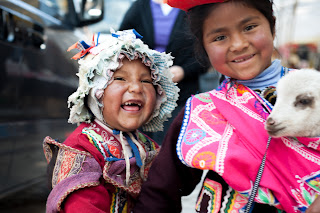Children peek out from inside this house.
Photo courtesy of Stephen Waugh
We also stop at a wool farm/camelidae petting zoo. The llamas, alpacas, and vicuñas are relatives of the camel.
They give us alfalfa to feed and attract the animals. They are very greedy.
Alpacas:
Llamas (all shorn):
Photo courtesy of Stephen Waugh
There are also women weaving. They use many different plant and animal materials to get the bright colors.
Weaving woman photo courtesy of Jerry Waugh
There is a little shop here too. They have chocolate covered coca leaves for sale.
The next stop is Pisac Town, where there is a rather large market.
Two girls pose for a picture.
Cobblestone paving.
We stop at a bakery with delicious empanadas: bread filled with cheese, onions, and tomatoes, baked in an oven. Wow were they good.
They also have a guinea pig farm.
After the market, it's time to travel down the road some more to a local brewery.
Woman in the field near the road:
A red bag on a stick indicates there is a brewery here.
Here we have beer brewed from maiz, or corn.
The corn is ground up and fermented:
The brew-mistress pours us some cups:
It is pretty sour, but there is also a variety that is mixed with fresas, strawberries, which is a little sweeter.
She also has a guinea pig farm. Bar food, no doubt.
There is a courtyard outside.
In the courtyard, Juego de Sapo, or Frog Game, tables are set up.
The game is played by tossing coins at the table for points. Each slot is worth some points, but the sapo, the frog, is worth the most.
Whoever loses must pay for the others' beer.
Now, it's on to Ollantaytambo (oh yan ty TAM bo).
Once an important site of the Pre-Incas, Pachacuti destroyed the town and built his estate on top of the ruins. This act of rebuilding on top of your enemies destroyed sites shows superiority. The Spanish did the same when conquering the Incas.
Because of this, the site is a mixture of Pre-Inca and Inca stonework.
The base of Ollantaytambo:
Photo courtesy of Pauletta Waugh
On the mountainside across the village are more ruins.
These were abandoned at one point, but no one is exactly sure why.
At the top of the site:
The Inca blocks were massive, carried from the quarry across the valley and up the ramp alongside the mountain.
Notches on the sides of the stone, presumably for pulling up the ramp on the side of the mountain:
Large stones at the top:
Ollantaytambo village:
Terraces along the ruins:
Trail leading around the mountain:
Remnants of houses:
Steps going back down to the valley:
Fountain at the base:
After the tour of the ruins, we head to our hotel...
...where we have lunch.
Quinua salad:
The hotel has a rather large garden courtyard.
Tree tomatoes (tamarillo):
Avocados:
Flowers:
We also take some time to look around Ollantaytambo village.
A closer picture of the roof ornaments:
Streets and alleyways:
Aloe vera grows to be very large:
We return to our hotel that evening, and are greeting by a nice view from our balcony:
and delicious food:
Peruvian hot toddy:
Potato dippy appetizer:
Fish:
Buenos noches! Tomorrow we board the train to Aquas Calientes.


























































No comments:
Post a Comment